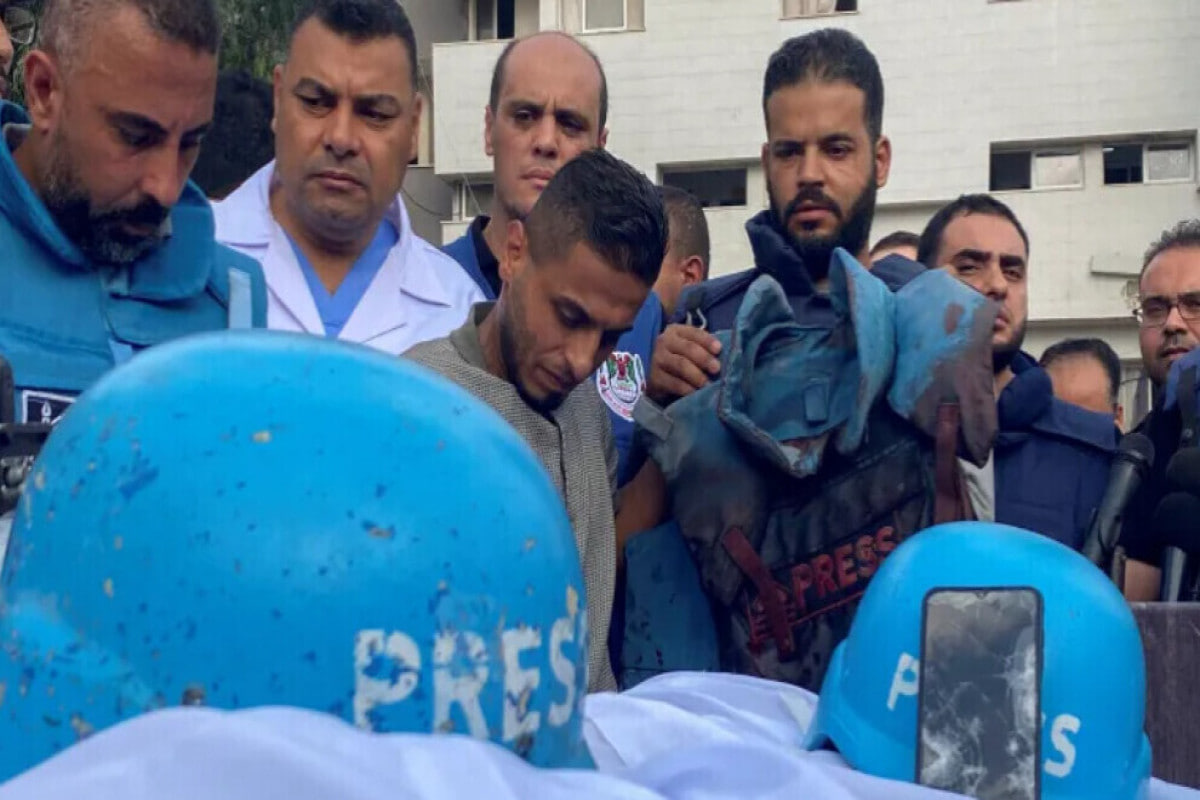Along with other acts of violence against journalists, the Israel-Hamas war has resulted in the deaths of several journalists, making it the deadliest conflict for journalists in the twenty-first century as well as the deadliest phase in the Israeli-Palestinian conflict since 1992. As of September 2024, 116 journalists had been killed by the Committee to Protect Journalists 111 Palestinian, 2 Israeli, and 3 Lebanese, while 134 journalists and media workers had been killed by the International Federation of Journalists 127 Palestinian, 4 Israeli, and 3 Lebanese.
According to a count conducted in July 2024 by the official media office in Gaza, there have been 160 Palestinian journalists slain.
“Israel’s war on Gaza is more deadly to journalists than any previous war,” declared the head of the Committee to Protect Journalists on January 30, 2024. Additionally, an estimated 48 media facilities in Gaza were damaged or destroyed by Israeli bombings. According to Reporters Without Borders, Palestinian and Lebanese journalists were deliberately targeted by the Israeli army.
The Guardian challenged Israel’s statement that it targets journalists by stating that it has targeted Palestinian journalists linked with Hamas in violation of international law, even though these journalists have not participated in hostilities. Nearly 75% of journalists slain globally in 2023 were Palestinians who had lost their lives in Israel’s Gaza War.
Over 43,000 people—41,802 Palestinians and 1,706 Israelis—had been reported murdered in the Israel–Hamas conflict as of October 4, 2024. Among them were 128–139 journalists and media personnel. The International Federation of Journalists and the Committee to Protect Journalists report that there are 123–129 Palestinians, 2-4 Israelis, 3-5 Lebanese, and 1 Syrian.120 scholars and more than 224 assistance workers—including 179 UNRWA staff members—are involved.
Over 60% of Gazans have lost family members since October 7, 2023, according to a PCPSR report, which states that the great majority of casualties have occurred in the Gaza Strip. The demographic breakdown represents a subset of individuals who have been individually identified, but the Gaza Health Ministry’s GHM total represents all recorded deaths directly related to the conflict. 34,344 Palestinians whose identities had been verified had their names, genders, and dates of birth made public by the GHM on September 17, 2024. This accounts for over 80% of the casualties that have been documented thus far, 60% of which were not males of combat age. Those who have passed away from “preventable disease, malnutrition and other consequences of the war” are not included in the GHM total.38 The Gaza Health Projections Working Group estimated that illness and birth difficulties would cause thousands of additional deaths.
1,195 persons were killed in the strikes on Israel on October 7, including 815 civilians. During the initial onslaught on Israel, 251 more people were held captive in the Gaza Strip. In the occupied West Bank, which includes East Jerusalem, there have been 9 Israeli deaths and 479 Palestinian deaths, including 116 minors. There have also been casualties in Yemen, Iran, Syria, southern Lebanon, and other locations of Israel.
The recent wave of deaths has been denounced by the Arab and Middle Eastern Journalists Association, which has reiterated that “targeting journalists is a stark violation of press freedom and international human rights law”. “More journalists were killed in the first three months of the Israel-Gaza war than have ever been killed in a single country over an entire year,” according to the Committee to Protect Journalists. Journalist Salma al-Qadoumi was allegedly shot in the back by Israeli forces in August 2024 as she was covering events in Khan Younis.
Along with the dead, missing, and jailed, the Committee to Protect Journalists says that “48 media facilities in Gaza have been hit or destroyed” based on multiple accounts of damage done to journalists’ homes and workplaces. A Palestinian journalist claimed that Israel had targeted the residences of two journalists on February 5, 2024, when they published authenticated footage of a residential building in Khan Younis’ Al-Amal area going up in flames.
The IDF shot and injured Mohammed Balousha, a journalist who broke the story of premature newborns dying at the Nasr pediatric hospital in Gaza. According to Hossam Shabat, the IDF threatened to bomb his home if he didn’t leave Beit Hanoun, and they followed through on their promise when he didn’t. Two Al Jazeera reporters were assaulted and physically assaulted by Israeli forces on December 29 in the West Bank. Mansour Shouman, a Canadian citizen and journalist, was reported missing in January 2024, and it was believed that he was either dead or imprisoned during his evacuation from Khan Younis to Rafah, according to the Canadian authorities. After being shot by an Israeli sniper drone in February 2024, a journalist had his leg removed.
On February 20, footage from Shehab News Agency showed Israeli gunfire in Gaza City targeting journalists. Journalist Tareq Abu Azzoum of Al Jazeera said, “We don’t know the reason for this attack, if it was done to prevent us from reporting on the war,” after he almost got hit by an Israeli drone on February 27. It’s complete mayhem.” Journalist Ismail al-Ghoul, who was present in Al-Shifa Hospital during Israel’s raid in March 2024, claimed that after twelve hours, journalists were blindfolded, stripped naked, and made to lie on their stomachs for questioning.
After Israeli writer Israel Frey prayed for the victims of the Gaza conflict, a right-wing mob in Israel invaded his home and forced him into hiding, threatening his family. During the Jerusalem Day march in June 2024, far-right Israelis attacked journalists. Following an Israeli attack in the Gaza Strip in October 2024, Al Jazeera cameraman Ali al-Attar was in severe condition.
Since Israel declared war on Hamas after their strike against Israel on October 7, 2023, the conflict between the two countries has had an unparalleled impact on Gazan journalists. It was the deadliest period for journalists since CPJ started collecting data in 1992, with at least 128 journalists and media workers among the more than tens of thousands killed in Gaza, the West Bank, Israel, and Lebanon since the war began as of October 16, 2024, according to CPJ’s preliminary investigations.
They attempt to report on the conflict, which includes starvation, 90% of Gaza’s inhabitants being displaced, 80% of its structures destroyed, and devastating Israeli bombardment. More than 130 cases of possible killings, arrests, and injuries are being looked into by CPJ, though many of them are hard to record in these challenging circumstances.
“Journalists have paid the ultimate price—their lives—for their reportage ever since the Gaza War began. Carlos Martinez de la Serna, the director of the CPJ Program, stated in New York that “they are still doing their crucial jobs to tell the world the truth, even without protection, equipment, international presence, communications, or food and water.” “Every time a journalist is murdered, maimed, detained, or exiled, we lose pieces of the story. The perpetrators of these deaths will stand trial twice: once under international law and once in front of the merciless eyes of history.
Since they are citizens, journalists are safeguarded by international law. It is illegal to intentionally attack civilians during a war. The International Criminal Court declared in May that it was looking to issue arrest warrants for Israeli officials and Hamas in connection with war crimes and crimes against humanity. As of right now, CPJ has established that at least five journalists—Issam Abdallah, Hamza Al Dahdouh, Mustafa Thuraya, Ismail Al-Ghoul, and Rami Al Refee—were specifically targeted by Israeli troops in killings that CPJ categorizes as murders. In at least ten additional examples that suggest potential targeting, CPJ is currently looking into the specifics to confirm the information. Around the time of the war’s first anniversary on October 7, three additional journalists were injured and two more journalists were killed in Gaza, leading CPJ to once again demand an end to Israel’s impunity for attacking journalists.
In addition, CPJ is looking into several unverified reports alleging that other journalists have been murdered, gone missing, injured, threatened, or had their homes and media offices damaged. The names on the list of deceased journalists that we have in our database come from media reports and information gathered from CPJ’s contacts in the area. It encompasses every journalist* engaged in news reporting. While it is still unclear if all of these journalists were covering the violence when they were killed, CPJ has counted them as it looks into their circumstances.
The list is updated frequently, and names are taken off if CPJ verifies that the media personnel in question were not employed by the media at the time of their deaths, injuries, or disappearances.
The list is updated frequently, and names are taken off if CPJ verifies that the media personnel in question were not employed by the media at the time of their deaths, injuries, or disappearances.
Defense Forces of Israel Media outlets have been informed by IDF authorities on multiple occasions that the army does not intentionally target journalists. Not long after the war began, it also informed agencies that it was unable to ensure journalists’ safety. The CPJ has demanded a halt to the long-standing trend of impunity in IDF-killed journalist cases.
“Alarmed at the extraordinarily high numbers of journalists and media workers who have been killed, attacked, injured and detained in the Occupied Palestinian Territory, particularly in Gaza, in recent months blatantly disregarding international law,” United Nations experts expressed their concerns about the killings of journalists in a statement from February.
One year after the October 13, 2023, targeted Israeli attack in southern Lebanon that killed Issam Abdallah and injured six journalists, there is still no accountability.
On October 13, 2023, at 6:02 p.m., not than a week into the Israel-Gaza conflict, the Israeli forces fired two tank shells into south Lebanon, separated by 37 seconds. Who is the target of the military? Seven reporters wearing distinctly marked “Press” jackets and standing next to a car with the name “TV” are reporting from a hilltop approximately one mile away from the nearest point of conflict.
Issam Abdallah, an experienced video journalist for Reuters with a wealth of experience covering the conflict in his home in Lebanon, Syria, Iraq, and Ukraine, was instantaneously murdered by an Israeli assault. Photojournalist Christina Assi of Agence France-Presse AFP, who is also from Lebanon, suffered injuries that necessitated the amputation of her right leg. Five other journalists were also injured: American Dylan Collins of AFP; Carmen Joukhadar and Elie Brakhya of Al Jazeera, both from Lebanon; and Iraqi Thaer Al-Sudani and Maher Nazeh of Reuters.












